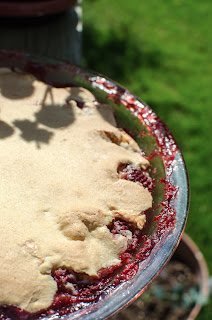efore I begin my review of Gaining Ground, allow to me to make a quick disclaimer: I am not an objective reader. In fact, I have worked for Forrest at farm markets every weekend for over a year now, in rain, snow, wind, thunder and tourist season. Before Smith Meadows came into my life I was largely vegetarian in order to avoid sponsoring the horror stories I read about the papers and books like
Omnivore's Dilemma and
Deep Economy. Then, through a boyfriend's friend's sister's best friend I found Smith Meadows, the perfect local farm with all the practices and principles an idealist could hope for.
Forrest Pritchard is Smith Meadows' farmer, its steward and practically a part of the soil he has worked so hard to nourish from the sad state it was in after years of overuse. As it turns out, lush pasture is easily achieved through a combination of patience and well planned herd rotation, switching between cattle, pigs, chickens and sheep, letting each fertilize and refresh the soil in turn. "Easily," of course, is a relative term when one is reading about it all from a comfy chair with a nice cup of tea.
In truth, it took not only years of hard work but decades of failure for the Pritchard family farm to turn around and produce a profit (as well as valuable land, animals and a sterling example of good farming practices). Gaining Ground recounts the journey Forrest took his entire family on when he realized that farming might be more of a calling for him than teaching (though writing is clearly still in his repertoire). As a bit of a book connoisseur, I did note that the book itself has a good looking, glossy cover, the text is printed clearly on nice feeling paper and the photos are incredibly helpful in placing the reader right there on the farm.
Gaining Ground has a good flow that kept me impatient to turn the page for the next adventure or roadblock, even though I knew exactly how it turned out. Forrest's anecdotes are sometimes touching, often hilarious, and range from rampant hogs to very confused market customers to a couple of completely baffling exchanges with a butcher. Pedro the goat, for instance, accompanied by Travis the humming farmhand, has a highly amusing adventure with some marigolds, in true goat-style.

As somewhat of an insider, I also know that there is a lot left out of this 317 page book. There were more adventures with goats, some ducks, more about Nancy's pasta business, a food truck and many more humorous stories from market and the farm. One hopes there will be a second book in the works... I, for one, would have enjoyed the inclusion of Forrest's other writing, perhaps the poetry he mentions sending off to literary magazines early on. The book stands at the right length and breadth to be a reasonable and fun read (One of
Publishers Weekly's top 10 summer reads in nonfiction), though the prose could have dug a little deeper into the emotional underpinnings here and there.
The other members of the family receive occasional mentions, but the elder Mr. Pritchard has a fair share of the spotlight as he does his best to support his harebrained son through the snafus and disappointments of starting his free-range, grass-fed meat business. Mr. Pritchard's declining health provides a backdrop that Forrest puts to use in framing the problems with the commercial food industry and how we think about food in terms of cost, taste and enjoyment. On the whole, Gaining Ground is a good story, not an essay on farming practices, and it is this difference that will help readers to understand on a personal level what it means to buy local and why they too should work to save the family farm.
I did have one customer at market ask if Gaining Ground was a collection of recipes from Smith Meadows Kitchen, and when I passed this along to Forrest he said, "Sure, it's a recipe book. There's a real important recipe in there, they'll just have to read all the way to the end."
Gaining Ground is available on
Amazon.com, in hardcopy and Kindle editions, and on
IndieBound, as well as at your friendly
local DC farm markets listed here. If you bring your copy to Smith Meadows
farm day on June 1, Forrest will be happy to sign it for you. He may even sign copies brought to the Arlington and Takoma Park markets where he usually can be found on weekends. I will be putting my signed review copy in the
Little Free Library for which I am co-steward. Pass it on!
 t's not that I'm unaware there are other things I should be doing, it's just that I'd rather be doing something with immediate, tangible results. Presumably this has been part of the appeal of manual labor for this generation that feels stuck and, well, flail-y. So instead of working toward long-term goals, I often find myself taking solace in some small projects around the house and yard.
t's not that I'm unaware there are other things I should be doing, it's just that I'd rather be doing something with immediate, tangible results. Presumably this has been part of the appeal of manual labor for this generation that feels stuck and, well, flail-y. So instead of working toward long-term goals, I often find myself taking solace in some small projects around the house and yard.


















